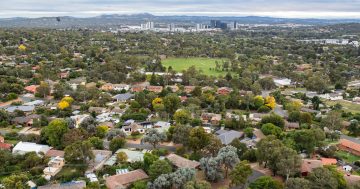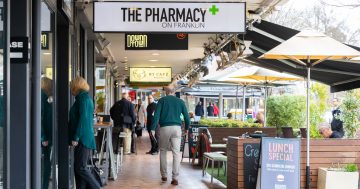
Why is a thriving small business like the Capital Region Farmers Markets hidden away in Canberra? Photo: Capital Region Farmers Markets.
Kids in Canberra go to and from school without seeing many, if any, businesses in operation.
Perhaps they will see a small shopping centre embedded in the middle of their suburb, but a complete education is more than the curriculum in schools – it is also about experiencing the real world.
What kids see as they travel around is important, and in Canberra, you have to go a long way to see the joy of a large number of functioning businesses with a lot of different jobs.
That is why, if and when I become Chief Minister, I will immediately organise to have all school children transported at least once a week through Fyshwick. Then they would see all sorts of businesses and people working and trucks and utes. They’d see competition in action, a full range of occupations and commerce happening right before their eyes.
I would also transport all the policy-making public servants through Fyshwick and Mitchell and Hume twice a week. The people who write policy about business and the economy actually don’t see an economy in action when they drive or bus or tram to and from work.
Why is our city so remote from businesses?
My understanding is that the great designers of our city, the Burley Griffins (Marion and Walter), had a much more realistic view of the need for businesses in a modern city. But their plan was modified by business-detesting chardonnay socialists to hide businesses from sight. (I will come to the shiraz-swilling developers and big landlords later.)
These ideologists took over the Burley Griffins’ plan to make sure the dirty little businesses were kept out of sight and as far away as possible so that if the King or the Queen visited Canberra they would not see something as unsightly as a shop, or a car yard, or a plumbers’ depot.
Once I read a quote from an architect for the then-new Parliament House as it was being built. It went something like this: “We want to keep the dirty businesses away and out of sight.”
And that pretty much sums up the ACT/Canberra planners’ view of business.
This is not natural.
In years past, a common complaint from visitors to Canberra was ‘Where are the service stations?’ (as they panicked about running out of petrol).
Another example of the lack of interest or care in businesses is that the light rail initially did not have a station at Mitchell – the only industrial suburb that it ran through. It seems the powers to be decided that the pesky ugly businesses in Mitchell and their unworthy non-public servant workers should be treated with disdain. There is a station there now but what a telling oversight.
As for the shiraz-swilling developers and big landlords? Well, they fell in with the biggest retailers and used their power and money to create big malls that all looked the same, with the same businesses.
These malls captured most car parks and bus interchanges. This helped kill off interesting independent retail businesses and was supported for too long by those who claimed to represent all businesses but really only supported the big end of town.
There is good news, to a degree, though. We do have some vision for a different sort of city. We see really interesting places springing up from the mistakes of the past. Lonsdale and Mort streets in Civic, the markets at Fyshwick and Belconnen. The Kingston Foreshore. Picturesque Pialligo. Verity Lane Markets.
We see some fabulous cafes and restaurants in our suburban shopping centres. Still, the government has made it hard. There is enough retail space in the ACT to service a population of one million. That makes it very hard for those not in a mall – and malls are not pleasant places for independent businesses to thrive. Malls are essential but should not be the only choice for consumers because they are inherently boring and predictable.
Free up the small business people, not just retail and hospitality, so they too can be seen and heard. Then we will have a much more vibrant capital city. And our kids will be better educated.
Peter Strong was a Canberra business owner and CEO of the Council of Small Business Australia (COSBOA) for 11 years. He now consults on community economics.
Original Article published by Peter Strong on Riotact.











